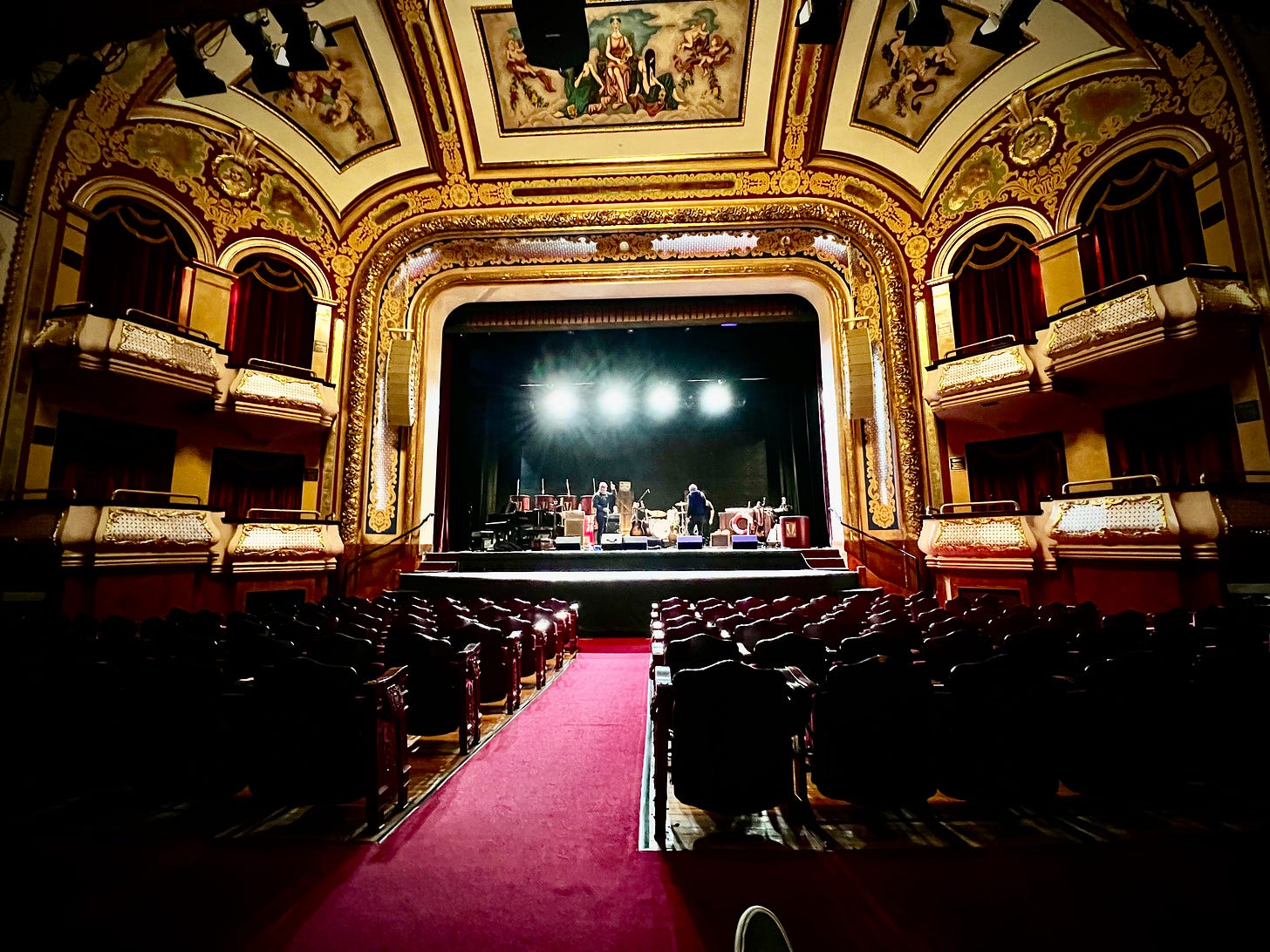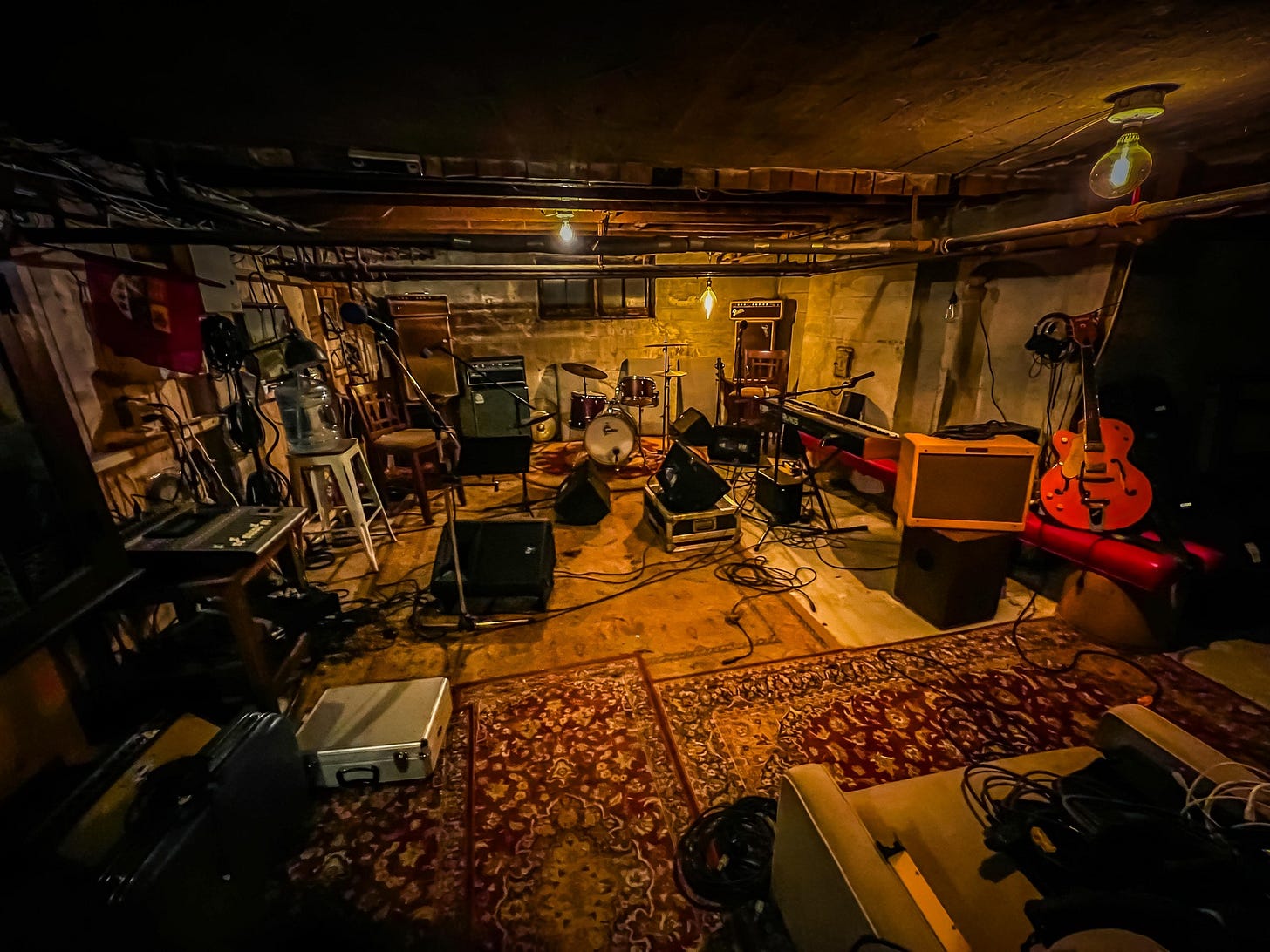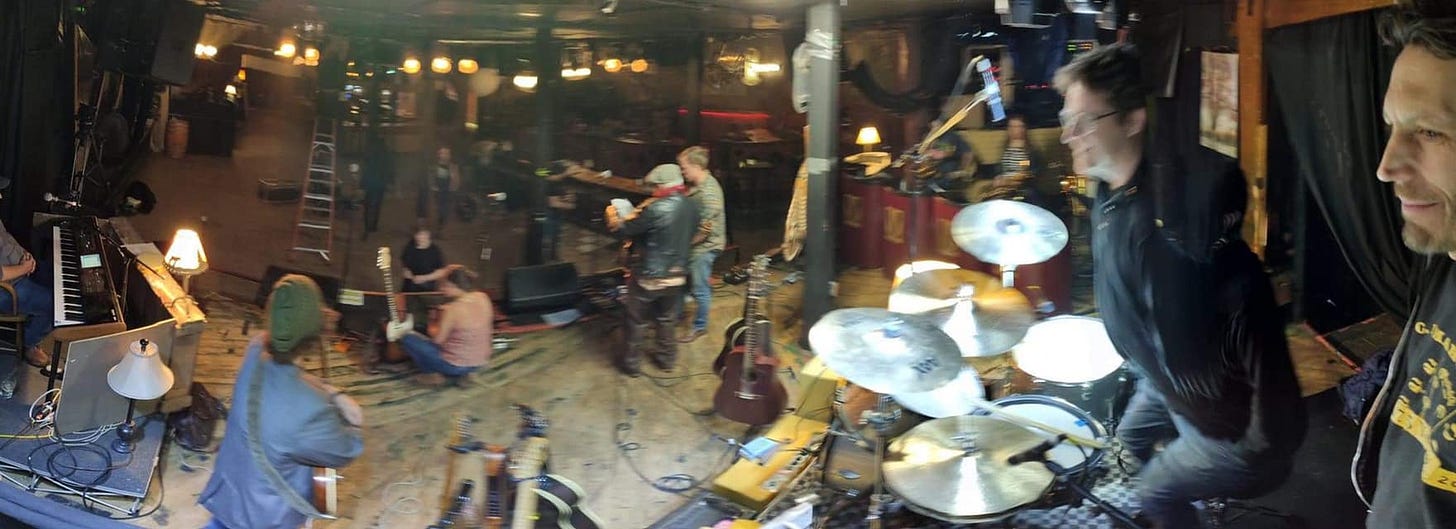The Problem with Local Music
Before They Were Famous, They Played Here. What Happens When ‘Here’ Disappears? Inside the secret life of local music and your new favourite band's existential struggle to get their first gig.
Nova Scotia is a musical place. Music isn’t just entertainment here—it’s identity, heritage, and connection. I’ve spent a lifetime immersed in the business of music and storytelling, and it’s impossible to ignore that music tells some of our best stories. Our grassroots music venues (GMVs) have been where it all begins: where legends first play, where creative communities gather, and where the next generation of interesting people pick up their instruments and take their first shot at the dream of sharing stories, music and ideas with others.
Yet these venues—the heart of our music ecosystem—are dissipating and disappearing. Economic pressures, redevelopment, and the shifting cultural landscape are wiping out the very spaces that gave us April Wine, John Allan, Sarah McLachlan, Sloan, Plaskett, and The Rankins. I’m taking this on because it’s a problem we can solve. We’ve done it before.
In the 1990s, Nova Scotia pioneered the Film Tax Credit (see the history section below), a model that transformed the province into a film production powerhouse. That wasn’t just about money; it was about recognizing and supporting the creative industries as integral to our economy and identity. Now, with music, we face a similar moment: a chance to act, innovate, and protect something fundamental to who we are.
This essay isn’t just a call to action; it’s a blueprint for a solution. It’s an idea rooted in fairness—ensuring that the massive economic output of big-ticket concerts supports the smaller stages where artists start. It’s about balance, sustainability, and a belief that culture deserves investment—not as charity, but as a cornerstone of progress, purpose, and prosperity.
I need to be plain-spoken here. Music doesn’t owe anybody a living. And if people don’t want to go to the show we can’t stop them. To turn on the Salvation Army’s old saying, You cannot warm the hearts of people with music if they have an empty stomach and cold feet. This idea is about creating sustainable opportunities that make music and livelihoods possible together for everyone.
By building a framework that respects the economics of both the audience and the artists, a Grassroots Music Venue (GMV) Tax Credit ensures that this is self-funding but it isn’t a zero-sum game. Through this system people can afford the ticket, performers can afford to play, and the show will go on. This is a solution worth considering because it brings value to everyone in a way that lasts.
My hope? To see Nova Scotia once again punch above its weight on the world stage, this time by protecting and nurturing the spaces where music lives. This isn’t nostalgia; it’s about the future. A future where musicians don’t have to leave to succeed, where small venues aren’t bulldozed for condos, and where we keep writing songs worth singing for generations to come.
This is personal, because we all take music personally. And, as I fret and worry about the leaky roofs, rickety risers, and eaked-out economics of our last remaining venues, I think it’s time we did something about it. We’re not alone. From Toronto to Austin, to London, everyone is looking for a formula to make this work because it’s important to everyone. I believe Nova Scotia has a real advantage and that we, more than any other place, can take the lead on this to show folks the way.
Like all things, it starts with talking about it, being increasingly dissatisfied with the things as they are, and imagining more and better for everyone.
I’d like to get your thoughts on all this.
— John Wesley Chisholm


A Grassroots Music Venue Support System for Nova Scotia
Nova Scotia’s music scene is deeply intertwined with its cultural identity. Yet, grassroots music venues (GMVs)—the incubators for local talent and community connection—are struggling to survive amidst economic pressures and redevelopment. To address this, a targeted support system inspired by the successful Nova Scotia Film Tax Credit could provide a sustainable solution.
Grassroots Music Venues in Canada: A Cultural Crisis
Canada’s musical heritage is a cornerstone of its cultural identity, yet grassroots music venues (GMVs)—the lifeblood of emerging artists and vibrant communities—are under siege. In Nova Scotia, a province renowned for its rich musical traditions and legendary performers, the situation is particularly dire. Economic pressures, rising real estate costs, and redevelopment projects are wiping out GMVs at an alarming rate, threatening the very foundation of the music ecosystem.
“I miss the Olands, I miss the bands, up on the Gus’s stage outnumbering their fans. I miss the late nights, when the lights come on. I miss the whole thing, but I’m the one that’s gone.”
Cheval - Singersongwrecker, Gone
The Role of GMVs in Nova Scotia’s Musical Heritage
Nova Scotia has long punched above its weight in music, producing iconic talents like Sloan, Joel Plaskett, The Rankins, Sarah McLachlan, and Rita MacNeil. Much of this success stems from the province’s GMVs, which have historically served as incubators for creativity, community hubs, and vital stepping stones for artists on their way to national and international stages. Venues like Gus’s Pub, The Carleton, Seahorse Tavern, and The Marquee Club have played pivotal roles in this ecosystem, offering intimate settings where musicians and audiences connect. The system of GMV’s in Nova Scotia once included all-ages venues like The Pavillion and Café Ole, along with The Kyber and other late-night venues. Music Halls, Theatres, and Society Halls were once central institutional gathering places for Nova Scotia life. Where New Brunswick has been able to keep many of its most illustrious halls including:
Capitol Theatre - Moncton, New Brunswick
Imperial Theatre - Saint John, New Brunswick
The Fredericton Playhouse - Fredericton, New Brunswick
Nova Scotia has no surviving grand GMV halls and has struggled to replace them with genuinely accessible space.
The dozens of school theatres and auditoriums that once served as community spaces for small events are now out of bounds for risk management and other fear-based reasons, and the few that are publicly owned spaces that are available, such as the Saint Mary’s Boat Club Hall are now priced, and red taped, far out of the reach of any GMV purpose.
The Economic and Developmental Squeeze
The economic landscape has shifted dramatically. Skyrocketing property values in urban centres like Halifax have made it nearly impossible for small, independent venues to survive. Redevelopment projects, often marketed as revitalization and even more ironically promoted on their proximity to cultural venues and scenes that they ultimately destroy, prioritize luxury apartments and commercial spaces over cultural institutions, leading to the closure of iconic GMVs. Those that remain face insurmountable challenges: higher rents, noise complaints from new residents, and the lingering financial fallout of the COVID-19 pandemic and corporatized big-boxification of the music industry.
The problem isn’t unique to Nova Scotia—cities across Canada, America, and the UK face similar struggles. In Toronto, The Hideout and The Silver Dollar Room are recent casualties, while in Vancouver, venues like The Railway Club have disappeared. Yet in Nova Scotia, where music is not just entertainment but a critical thread in the social fabric, the loss feels especially acute. Many in Nova Scotia still mourn the loss of the Flamingo and Double Deuce - the two venues that were the foundation stones of Nova Scotia’s 1990’s golden age of live music and successful bands.
Attached are two reports on the plight of and struggle to support GMVs.
Reimagining Music Venues – Ontario Study and Report
Grassroots Music Venues – UK House of Commons Report
What’s at Stake?
The erosion of GMVs isn’t just about the venues themselves. It’s about the entire ecosystem that supports live music: sound engineers, booking agents, bartenders, and even local economies that rely on the ripple effect of vibrant music scenes. It’s about the artists who no longer have spaces to hone their craft and the communities losing a cultural heartbeat that binds people together.
Music is more than entertainment; it’s a leading economic, cultural, social, educational, and technological indicator, often serving as society’s early warning system and creative engine. Music is a university for community and cultural activists of all sort. Music consistently picks up on emerging trends, reflecting and even predicting shifts in technology, identity, and culture before they hit the mainstream. It shapes not only our playlists but also the values and innovations of future generations. No cultural industry has a more profound influence on the trajectory of a community, city, or province than its music. From fostering local pride and international recognition to driving economic activity and educational engagement, music builds the connective tissue of a thriving society. By supporting and investing in grassroots music, we’re not just preserving heritage; we’re actively crafting the future.
What Can Be Done?
Nova Scotia has long been a pioneer in cultural innovation, using creative and impactful policies to punch above its weight on the world stage. Among its most successful tools is the labour-based tax credit—a proven, self-sustaining model that transformed the province’s film and television industry (see the history below) into a global powerhouse.
Now, with grassroots music venues (GMVs) and the ecosystems they support at risk, Nova Scotia is uniquely positioned to apply this tested strategy to a new challenge. By adapting our labour-based tax credit framework to support GMVs, we have the opportunity to not only revitalize live music and entertainment in the province but also to set a bold example for the world in how to sustainably fund and nurture culture.
The live music levy/tax credit is a proposed mechanism aimed at supporting grassroots music venues (GMVs) by redistributing a small percentage of ticket revenues from large-scale concerts and events. The levy, set at around 2% of ticket sales, would create a sustainable funding stream to help smaller venues thrive amidst economic pressures and redevelopment. This system recognizes the interconnected nature of the live music ecosystem, where major acts often build their careers in GMVs, and seeks to ensure these foundational spaces remain viable. By reinvesting in grassroots venues, the levy aims to protect the future of live music and foster a diverse cultural landscape.
Implementing a support system for Nova Scotia's grassroots music venues (GMVs) inspired by the successful Nova Scotia Film Tax Credit involves two key components:
Levy on Large Concert Tickets: A 2% or $2 per ticket surcharge on tickets sold for large-scale concerts in arenas and stadiums.
GMV Tax Credit: A fully refundable industrial tax credit, amounting to 33% of eligible Nova Scotia labor expenditures incurred by GMVs on Nova Scotia Talent.
Revenue Generation from the 2% Levy:
The Concert & Event Promotion industry in Nova Scotia is projected to generate approximately $156.6 million in revenue in 2024.
Assuming that conservatively 50% of this revenue comes from large-scale concerts (concerts that are major national or international touring acts that significantly draw entertainment dollars away from GMV’s and extract wealth from our economy) subject to the levy, the calculation would be:
Total revenue from large-scale concerts: $156.6 million * 50% = $78.3 million
Revenue from 2% levy: $78.3 million * 2% = $1.566 million
For perspective the Scotiabank Centre in Halifax, which is a major arena, sells over 100,000 concert tickets per year with an average ticket price of about $100. At 2% or $2, this venue alone could generate over $200,000 in GMV levy.
Cost of the GMV Tax Credit:
Estimating the total eligible labor expenditures for GMVs is challenging due to limited data. However, if GMVs report $4 million in eligible Nova Scotia labor expenses annually, which might represent 1-2,000 GMV annual events, the tax credit would be:
GMV labor expenditures: $4 million
Tax credit (33%): $4 million * 33% = $1.32 million
Net Financial Impact:
Revenue from levy: $1.566 million
Cost of tax credit: $1.32 million
Administrative cost: $200,000
Net surplus: $1.566 million - $1.32 million - $200,000 = $46,000
Benefits:
Sustainable Funding: The levy provides a consistent revenue stream to support GMVs without imposing additional taxes on the general public or requiring ‘arts funding’ type applications, deadlines, panels, and pick-a-winner type programs.
Economic Growth: Supporting GMVs can stimulate local economies by attracting tourists and creating jobs.
Cultural Preservation: Ensuring the survival of GMVs helps maintain Nova Scotia's rich musical heritage and future.
Incentivizing: Better and more regular pay for Nova Scotia creative talent
Formalization of the Music Economy: The tax credit encourages above-the-board transparency in financial reporting within the music industry generating more tax revenue for the province.
Considerations:
Administrative Oversight: Implementing and monitoring the levy and tax credit will require administrative resources, which are allowed for in the calculation.
Industry Compliance: Ensuring that large venues comply with the levy and that GMVs accurately report labor expenditures is crucial.
Economic Variability: Fluctuations in concert attendance and GMV operations could affect revenue and expenditure estimates.
By adopting this dual-approach system, Nova Scotia can create a sustainable model to support its grassroots music venues, fostering both economic and cultural benefits for the province.
To explore this concept the Province could implement a 2-year voluntary pilot project that included just the Scotiabank Centre ticketing and the qualifying core Halifax Entertainment district GMV’s.
Notes: The Nova Scotia Film Tax Credit - a labour-based industrial tax credit system that changed the way film financing works globally.
The Nova Scotia Film Tax Credit, established in 1995, was a pioneering initiative that transformed the landscape of film financing and brought a new level of progress and prosperity to film and TV jobs in Nova Scotia. At a time when most film funding models were dependent on government grants or unpredictable private investment, Nova Scotia created a system that was both innovative and self-regulating. This credit provided a stable, predictable, and YES, even literally bankable financial framework for the burgeoning local film industry. By tying funding directly to production Nova Scotian Labour in the province (meaning people who lived and paid taxes in Nova Scotia), the program ensured that investment directly benefited the local economy—paying crew wages, supporting local businesses, and creating jobs—while fostering a vibrant creative industry.
What set the Nova Scotia Film Tax Credit apart was its removal of subjective judgments about the artistic merit of a project from the funding process. Unlike traditional arts funding models, where decisions could hinge on opaque or politicized criteria, often running out of money or having short application windows, the tax credit was purely transactional - any time a film or TV show was commissioned, the Tax Credit could be used to complete the financing or support future growth.
The new system drastically reduced the red tape, waiting time, administrative cost, deadlines, application windows, complexity, empty funds, discouraging competition between creative producers, and vagaries of traditional arts funding.
It was designed with built-in checks and balances that ensured producers could access funding only by meeting clear, measurable criteria, such as hiring local workers or spending a certain percentage of their budgets in Nova Scotia - and always carefully reporting, reviewing, and auditing the results to ensure everything was working as it should. This made the system uniquely attractive to both producers and financiers, as it offered predictable results with careful controls and oversight. Banks and other financial institutions, confident in the integrity of the system, quickly began "interim financing" the tax credits upfront, allowing filmmakers to secure funding to cash flow even the largest and most complex projects. By creating an efficient, industry-first labour-based approach to cultural development, Nova Scotia led the world in demonstrating how the creative industries could be both a cultural and economic powerhouse. In doing so, the province established a competitive advantage and talent base that is still returning capital and dividends almost 30 years later.
This 30-year proof of concept seems to me to be a solid, well-proven foundation on which to build a new tax credit system for other sectors of the creative economy that deserve it, and would benefit from it, just as much as the film and TV sector.
Contact:
John Wesley Chisholm
Arcadia Entertainment
Suite # 301
6454 Quinpool Road
Halifax, Nova Scotia
B3L 1A9
Tel: 902.225.0763
Email: jwc@arcadiatv.com







Really interesting read and hopefully will encourage further action. I am fortunate to work for Music Venue Trust in the UK and the CMS report has been a major step in bringing forward industry support for the grassroots sector.